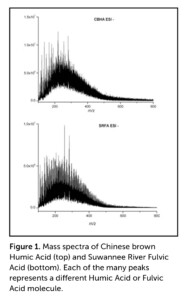Fertilgold® Organics, a brand of organic fertilizer products from Bio Huma Netics, Inc. (BHN) headquartered in Gilbert, Ariz., has achieved Organic Materials Review Institute (OMRI) listing for 24 initial products. Of these, 18 OMRI-listed liquid crop nutrition products are based on the company’s proprietary nutrient carrier, Micro Carbon Technology®, which carries nutrients to plants more effectively than traditional organic nutrition products.
OMRI-Listed Fertilgold® Organics products currently include:
Fertilgold® Soil (liquid: nitrogen, iron, manganese, zinc)
Fertilgold® N-5.5 (liquid: nitrogen)
Fertilgold® NK (liquid: nitrogen and potassium)
Fertilgold® K-6 (liquid: potassium)
Fertilgold® 3-2-5 (liquid: nitrogen, phosphorus, potassium)
Fertilgold® B (liquid: boron)
Fertilgold® Ca (liquid: calcium)
Fertilgold® Co (liquid: cobalt)
Fertilgold® Cu (liquid: copper)
Fertilgold® Fe (liquid: iron)
Fertilgold® Mg (liquid: magnesium)
Fertilgold® Mn (liquid: manganese)
Fertilgold® Mo (liquid: molybdenum)
Fertilgold® MoN (liquid: molybdenum, nitrogen)
Fertilgold® Zn (liquid: zinc)
Fertilgold® Micros I (liquid: a balanced mix of S, B, Cu, Fe, Mn, Mo, and Zn)
Fertilgold® MicroHumic® (dry: humic/fulvic acid)
Fertilgold® Powder (dry: humic/fulvic acid)
Fertilgold® Greens (dry: humic/fulvic acid)
Fertilgold® 1–3 mm (dry: humic/fulvic acid)
Fertilgold® K Hume (dry: humic/fulvic acid)
Fertilgold® 6 mm(-) (dry: humic/fulvic acid)
Fertilgold® Double Play™ (liquid: soil-applied fungicide and nematicide)
Fertilgold® Triple Play™ (liquid: foliar-applied insecticide, miticide, fungicide)
These products are currently available for sale to commercial organic growers in select states (check availability at https://fertilgold.com/shop/), and they will soon be registered and available throughout the United States and in several other countries. Additional products that are currently undergoing review for OMRI listing are in the categories of Soil Fertility, Macronutrients, Liquid Humic and Fulvic Acids, Biopesticides, and Surfactants.
Lyndon Smith, BHN President and CEO, stated, “For years, customers of our bestselling Huma Gro® crop nutrition and protection product line for conventional farming have been asking us to develop a fully organic product line that is also powered by our Micro Carbon Technology®. The folks on our product development team have done an outstanding job with creating the Fertilgold® Organics products, which we think will redefine organic crop nutrition. We are offering a full line of effective products that have been designed to deliver true organic nutrition exactly when, where, and how crops need it. Anyone familiar with the outstanding crop yield and quality results achieved by our Huma Gro® products on the conventional farming side is going to absolutely love what Fertilgold® Organics with Micro Carbon Technology® (for the liquid products) will do for their organic crops.”
More information is available on the Fertilgold® Organics Website (fertilgold.com), which will provide ongoing updates regarding new products, OMRI-Listed status for products, and state registration for each. Blog content will also flow out to followers on Fertilgold® Organics Facebook and Twitter social media channels.
Related Posts

What Differentiates Humic and Fulvic Acids?
By Richard Lamar, PhDDirector of Humic ResearchBio Huma Netics, Inc. For centuries, humic acids (HA) were thought to be composed of much larger molecules than those found in fulvic acids (FA). However, the application of Fourier-transform ion cyclotron resonance mass spectrometry (FT-ICR MS), which separates molecules on the basis of molecular weight, demonstrates that the

BIO ENERGIZER® Reduces Sludge at a Small Municipal Facility in Utah
A small municipality in Utah (pop. 1,800) had a wastewater system with a flow rate of 192,000 gallons per day. The system included a series of four lagoons, although at this time only Ponds 1 and 2 were being evaluated for treatment. The influent consisted of domestic waste as well as septic. Pond 1 was

This Week in Ag #15
“Your rows sure are straight.” Those may have been the most pride-filling words I ever heard. They were first spoken to me by one of my landlords, Orville Larson, the spring after my dad passed away and all farming operations fell entirely on me. Orville made a habit of driving out to his farm to see

